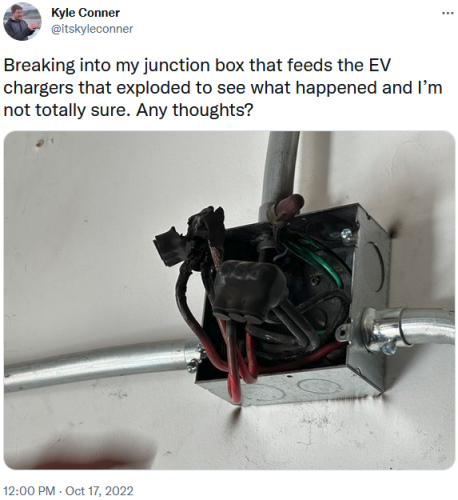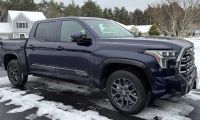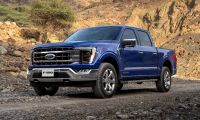Tom Moloughney, the world’s top expert on vehicle charging, has a warning for new battery-electric vehicle owners; Your home EV charger setup may not be as safe as it can be. His message is backed up by an example from a second expert's personal experience. These two are not just experts. They are 110% pro-EV in every possible way. Tom is the global leader in home EV testing, and among other things, Kyle Conner is the leading expert on real-world EV charging and charging curves (the rate at which an EV can charge based on its state of charge).
This week Tom released a video titled “How To Safely Charge Your EV.” The cover image for the video shows Tom holding two melted home EV charging electrical components that look as if they may have been on fire. In an October 2022 Tweet, Kyle shows an electric junction box that “exploded” and was part of his own home EV charging circuit. It is melted and looks as if it may have been on fire. So why are two die-hard EV advocates sounding the alarm?
Related Information: Electric Vehicle Charge Ports Can Also Melt
Home EV Charging Warnings From Experts
One might think that in order to install a home EV charger, all one needs to do to ensure safety is to call a licensed electrician. Shockingly, Tom says that is not really the case. Throughout his video, he repeatedly points out that not all licensed electricians are equal concerning home EV charger knowledge. We are now well into the second decade of the modern EV era, so it sounds odd that an electrician is not qualified to install an EV charger. Yet, these experts seem to be sending that message.
Related Information: EV Owners Discuss Failed Charger Systems
Not All Electricians Are Qualified - Not All EV charging Equipment Is Safe
Tom’s guest in the video is a Qmerit electrician. Tom and his electrician guest overview common issues that arise from inexperienced electricians. Improperly torqued connector fasteners, improper cable selection (Romex is no good), missing disconnects, and NEMPA 14-50 receptacles that Tom says are just not capable of handling the home EV duty cycle. All of which can lead to safety issues.
Related Story: Electric Vehicle Charging Is a Confusing Mess For New EV Owners
Safety Issues Despite Using Qualified Electricians
Kyle’s Tweet clarifies that he did hire a “professional electrician” to wire his home EV charger setup. After all, as a professional EV tester, Kyle needed a robust, safe, and fast system to keep his EVs charged for testing and evaluation.

Kyle has a very large online following (myself included). His Tweet generated pages of comments and images as replies. They break down into two main types of comments. First, folks showing images of their home EV chargers melted exploded, or formerly on fire. And second, armchair electricians who all see a long list of obvious problems with how the professional electrician wired Kyle’s EV charging circuit wrong, unsafely, or shoddily.
Tom’s Main Message - Don’t Use a Plug-In Home Charger
Tom’s video has one overriding theme. Don't use a plug-in home charger. Tom feels that the most likely failure point of one’s home EV charger setup is the receptacle. He and the guest electrician from Qmerit go deeply into the many reasons why they have this opinion, and we are not calling them wrong.
However, Kyle’s failure, and many of the ones posted under his tweet, had nothing to do with a receptacle. They had to do with wiring, junction boxes, breakers, and various other parts of the EV charging circuit. That makes figuring out how to easily make your home setup safe a lot murkier.
The Scariest Part of EV Charing Is How (When) They Fail
Tom and his qualified electrician guest from Qmerit also reveal a very disturbing fact backed up by Kyle’s example of a failed charging circuit. The failures often come after a long period of proper operation. Tom and his Qmerit expert electrician point out that it is the many cycles of use that worry them the most. Here, we were left a bit confused. Tom seems to imply that folks who use an EV charger (EVSE) with a receptacle (as opposed to hard-wired) may be assuming they will need to move their charger to a second home. However, the failures are not blamed on the actual plug connection but rather on the interior wiring of the NEMPA 14-50 receptacle. Wouldn’t a hard-wired unit also have internal wiring? The explanation is a bit unclear.
What Tom and his guest do make clear is that they feel the most likely cause of a failure is repeated heating and cooling cycles that can then loosen a connection and cause an arc or possibly even a short. That is scary thought, given the immense power passing through an EV charging circuit.
Tom also cautions against the use of aluminum wiring in the EV charging circuit. This one really surprised us. We would never have guessed a qualified electrician would use an aluminum wire from the panel to the EVSE connection. Apparently, it is not uncommon, and both agree it is a safety issue.
In the video, Tom provides a best practices punch list. Rather than recreate it here, let us encourage you to watch this video yourself. The point at which they discuss Kyle’s tweet is the timestamp 11:28. The best practices section is at time stamp 19:57.
Feel free to comment in our section below. This is one topic where user experience may help save another EV owner from real safety problems.
Image of home charger in use by John Goreham.
John Goreham is a long-time New England Motor Press Association member and recovering engineer. John's interest in EVs goes back to 1990 when he designed the thermal control system for an EV battery as part of an academic team. After earning his mechanical engineering degree, John completed a marketing program at Northeastern University and worked with automotive component manufacturers, in the semiconductor industry, and in biotech. In addition to Torque News, John's work has appeared in print in dozens of American news outlets and he provides reviews to many vehicle shopping sites. You can follow John on TikTok @ToknCars, on Twitter, and view his credentials at Linkedin
Re-Publication. If you wish to re-use this content, please contact Torque News for terms and conditions.












